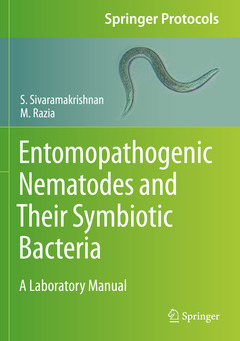Entomopathogenic Nematodes and Their Symbiotic Bacteria, 1st ed. 2021 A Laboratory Manual Springer Protocols Handbooks Series
Langue : Anglais

This book provides basic information and different protocols associated with the Entomopathogenic nematodes (EPNs) and their symbiotic bacteria. Entomopathogenic nematodes (EPNs) of the genera Steinernema and Heterorhabditis and their associated bacterial symbionts Xenorhabdus and Photorhabdus aid nematode infective juveniles (IJs) in infecting and killing their insect hosts, creating a unique tripartite complex of host-vector-symbiont interactions. Due to this insect killing capability, EPNs are used as biological control agents of economically important insect pests. They are also a model system to study host-parasite interactions.
It provides a systematic approach to various nematode procedures including pathogenicity, reproduction, foraging behaviour. It gives a brief outline on historical aspects, nematode-bacterium complex, biology and chemical ecology of EPNs. It concisely describes host insect rearing, nematode samplingand storage, isolation techniques, counting, handling and staining of nematodes, characterization including morphological, molecular and ecological studies, mass production, virulence bioassay, field application and efficacy. The book also includes methods and techniques for their associated symbiotic bacteria.
This book serves as a laboratory manual and assists the readers to undertake advanced research in different aspects related to nematodes. It is useful for researchers in the fields of nematology, microbiology, bacteriology and entomology.
Foreword.- Preface.- Acknowledgement.- Chapter 1: Safety Guidelines.- Chapter 2: Introduction.- Chapter 3: Historical Aspects.- Chapter 4: Nematode-Bacterium Symbiosis.- Chapter 5: Biology.- Chapter 6: Nematode Behaviour.- 7. Chemical Ecology.- Chapter 8: Laboratory Techniques for Entomopathogenic Nematodes.- Chapter 9: Laboratory Techniques for Symbiotic Bacteria.- Chapter 10: Field Application Techniques for Control of Insect Pests.- Chapter 11: Application Efficacy Against Insects in Other than Soil Habitats.- Chapter 12: Recent Advances and Future Prospect.- References.
Dr. S. Sivaramakrishnan is the Head, Department of Biotechnology, Bharathidasan University, Tiruchirappalli, India. He is engaged in research and teaching for over twenty years. His specialization is nematology, agricultural biotechnology, biopesticides and nanotechnological applications. He has won young scientists award four times. He is a member of the editorial board of European Journal of Nematology and is a reviewer for nearly ten journals. He is an active life member of Nematologist Society of India. He has scientific publications in national and international journals. He has been the principal investigator of major DBT, DST and UGC projects. He has international collaborations, signed MoU between USA, Korea, Iran and Turkey. He has organized international conferences and national awareness programme.
Dr. M. Razia is an Assistant Professor in the Department of Biotechnology, Mother Teresa Women’s University, Kodaikanal, India. She has an expertisein the areas of nematology, microbial biotechnology and phytochemistry. She is engaged in teaching and research activities for 15 years. She has published several scientific papers in reputed national and international journals. She has carried out major projects of UGC and DST-SERB. She has organized conference, seminar and workshops. She is a life member of Lichen Society of India, The Indian Science Congress Association, The Biotechnology Society of India and Association of Microbiology India. She has won the young scientists award.
Describes the EPNs and their associated bacteria Provides step-by-step protocols and self-explanatory illustrations Includes historical aspects, chemical ecology and behaviour of entomopathogenic nematodes
Date de parution : 04-2022
Ouvrage de 176 p.
17.8x25.4 cm
Date de parution : 04-2021
Ouvrage de 176 p.
17.8x25.4 cm
Thèmes d’Entomopathogenic Nematodes and Their Symbiotic Bacteria :
© 2024 LAVOISIER S.A.S.


